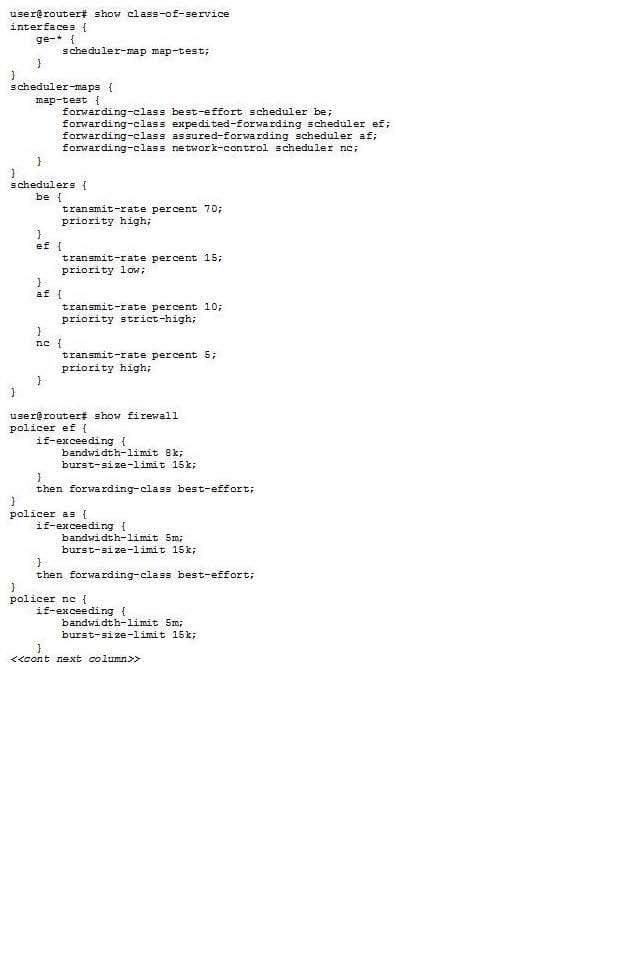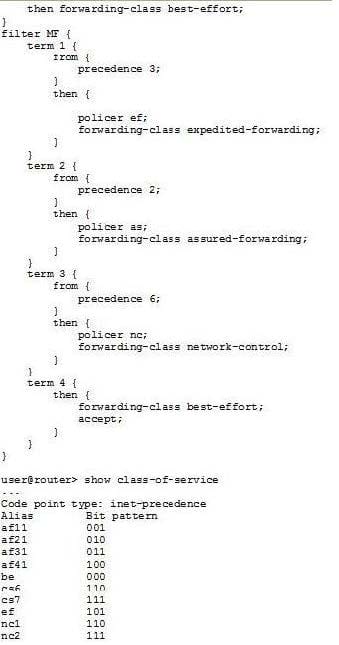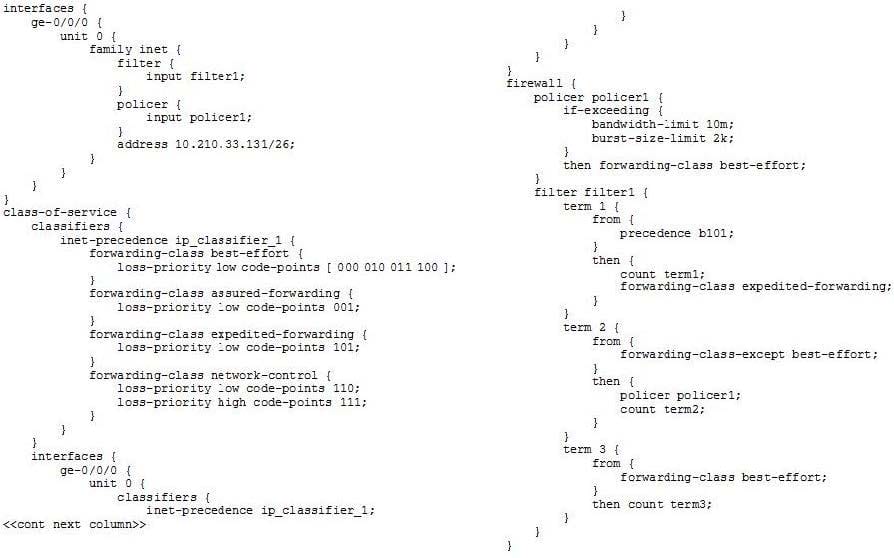Exam Details
Exam Code
:JN0-694Exam Name
:Enterprise Routing and Switching Support, Professional (JNCSP-ENT)Certification
:Juniper CertificationsVendor
:JuniperTotal Questions
:52 Q&AsLast Updated
:Aug 20, 2025
Juniper Juniper Certifications JN0-694 Questions & Answers
-
Question 11:
Interface ge-0/0/12 on Switch1 is connected to ge-0/0/12 on Switch2. You have configured both Switch1 and Switch2 to run MSTP. You see the CLI output shown in the exhibit.
What would cause this output?
A. Switch1 and Switch2 are configured with different autonomous systems.
B. Switch1 and Switch2 are configured with different bridge priorities.
C. Switch1 and Switch2 are configured with different names for their VLANs.
D. Switch1 and Switch2 are configured with different revision levels.
-
Question 12:
There is a lot of traffic marked with IP precedence values af2l and af3l that ingresses the router. The af3l traffic should be using the expedited forwarding queue, but the traffic is much lower than expected and there are no drops seen on the egress interface.


Referring to the exhibit, what is causing the problem?
A. The assured forwarding queue has a strict high priority and is starving the expedited forwarding queue.
B. The expedited forwarding queue has a low priority value; therefore the traffic is not serviced.
C. The MF classifier is forwarding most of the af3l traffic to the best-effort queue.
D. The MF classifier is does not match on af3l and therefore the traffic is being dropped.
-
Question 13:
You add a multicast source to a network. The source's DR sends register messages to the RP However, multicast clients are not able to receive traffic from the source. What are two causes of this problem? (Choose two.)
A. A reject policy is configured on the designated router.
B. The RP did not receive a PIM join message for the group specified.
C. A reject policy is configured on the RP.
D. The designated router must send a null register message to the RP.
-
Question 14:
You are monitoring a network that is configured with PIM sparse mode. An end user's PC (PC1) joins a multicast stream. The stream never switches from the rendezvous-point tree (RPT) to the shortest-path tree (SPT).
Which two statements explain this behavior? (Choose two.)
A. An interface on the SPT is not configured for PIM.
B. The designated router for PCI's LAN does not have a route to the multicast source.
C. This is the normal operation of PIM sparse mode.
D. This is a source-specific multicast (SSM) stream.
-
Question 15:
You are troubleshooting a problem where external routes are not being summarized into the OSPF backbone.

Referring to the exhibit, what needs to be done to resolve this problem?
A. The area-range parameter needs to be under Area 0.
B. The area-range parameter needs to be under the nssa hierarchy.
C. The summaries parameter needs to be removed under the/issa hierarchy.
D. The area-range parameter must include the override-metric parameter.
-
Question 16:
The exhibit shows part of the configuration for a router. You receive a complaint that the router is not correctly reclassifying all traffic to the best-effort forwarding class when the amount of IPv4 traffic exceeds 10 Mbps.

You have isolated the problem to traffic with the IP precedence bits set to the binary value 101. Which configuration is causing this behavior?
A. the filter firewall filter's term 1
B. the filter firewall filter's term 2
C. the ip_classifier_1 classifier
D. the policer1 policer
-
Question 17:
-- Exhibit -user@router# show class-of-service
classifiers {
inet-precedence ipp-test {
import default;
forwarding-class best-effort {
loss-priority low code-points be;
}
forwarding-class expedited-forwarding {
loss-priority low code-points af21;
}
forwarding-class assured-forwarding {
loss-priority low code-points af11;
}
forwarding-class network-control {
loss-priority low code-points nc1;
}
}
}
interfaces {
ge-* {
scheduler-map map-test;
unit * {
classifiers {
inet-precedence ipp-test;
}
rewrite-rules {
inet-precedence ipp-rw-test;
inet-precedence default;
}
}
}
}
...
rewrite-rules {
inet-precedence ipp-rw-test {
forwarding-class best-effort {
loss-priority low code-point be;
loss-priority high code-point af21;
}
forwarding-class expedited-forwarding {
loss-priority high code-point af21;
loss-priority low code-point be;
}
forwarding-class assured-forwarding {
loss-priority low code-point af11;
loss-priority high code-point af11;
}
forwarding-class network-control {
loss-priority low code-point nc1;
loss-priority high code-point nc1;
}
}
}
user@router> show class-of-service
...
Code point type: inet-precedence
Alias Bit pattern af11 001 af21 010 af31 011 af41 100 be 000 cs6 110 cs7 111 ef 101 nc1 110 nc2 111 -- Exhibit -
Click the Exhibit button.
Traffic with the IP precedence value af21 ingresses the router and should be rewritten with the same value as it egresses; however, this traffic is rewritten to a different value.
Referring to the exhibit, what is the source of this problem?
A. The BA classifier is assigning the traffic to the best-effort queue with a high loss priority.
B. The BA classifier is assigning the traffic to the best-effort queue with a low loss priority.
C. The BA classifier is assigning the traffic to the expedited forwarding queue with a high loss priority.
D. The BA classifier is assigning the traffic to the expedited forwarding queue with a low loss priority.
-
Question 18:
-- Exhibit -user@R1> show class-of-service interface ge-0/0/0 Physical interface: ge-0/0/0, Index: 134 Queues supporteD. 8, Queues in use: 4 Scheduler map: , Index: 2 Congestion-notification: Disabled
Logical interface: ge-0/0/0.0, Index: 69 Object Name Type Index Classifier ipprec-compatibility ip 13 -- Exhibit -
Click the Exhibit button.
You are sending traffic to the ge-0/0/0 interface on R1 with the expedited forwarding (101) IP precedence bits. However, the counters on the router show that it is not processing any traffic in the expedited forwarding queue.
Referring to the exhibit, what is causing the problem?
A. The classifier does not contain a mapping for this precedence value.
B. The classifier is assigning the traffic a high loss priority.
C. The classifier is assigning the traffic to the best-effort forwarding class.
D. The classifier is dropping the traffic.
-
Question 19:
-- Exhibit -user@switch# show vlans
ws {
vlan-id 23;
interface {
ge-0/0/12.0;
ge-0/0/6.0;
}
dot1q-tunneling;
no-mac-learning;
}
-- Exhibit -
Click the Exhibit button.
Referring to the exhibit, an administrator notices that all traffic is flooded out of all the ports in VLAN ws.
What would cause this problem?
A. no-mac-learning is enabled on the interface.
B. Spanning tree is disabled.
C. dot1q-tunneling is enabled on the VLAN.
D. Unicast destinations are flooded out of all ports.
-
Question 20:
-- Exhibit -user@router# show class-of-service
classifiers {
inet-precedence ipp-test {
import default;
forwarding-class best-effort {
loss-priority low code-points be;
}
forwarding-class expedited-forwarding {
loss-priority low code-points af21;
}
forwarding-class assured-forwarding {
loss-priority low code-points af11;
} forwarding-class network-control { loss-priority low code-points nc1; } } }
user@router# show firewall filter MF { term 1 { from { precedence 0; } then forwarding-class best-effort; } term 2 { from { precedence 5; } then forwarding-class expedited-forwarding; } term 3 { from { precedence 2; } then forwarding-class assured-forwarding; } term 4 { from { precedence 6; } then forwarding-class network-control; } term 5 { then accept; } } user@router> show class-of-service ... Code point type: inet-precedence Alias Bit pattern af11 001 af21 010 af31 011 af41 100 be 000 cs6 110 cs7 111 ef 101 nc1 110 nc2 111 -- Exhibit -
Click the Exhibit button.
Traffic with the IPP value af21 should be assigned to the expedited forwarding queue; however, this traffic is not being assigned to that queue.
Referring to the exhibit, what is causing this behavior?
A. The af21 traffic is assigned to the assured forwarding queue because of the BA classifier.
B. The af21 traffic is assigned to the assured forwarding queue because of the MF classifier.
C. The af21 traffic is assigned to the best effort queue because of the MF classifier.
D. The af21 traffic is assigned to the best effort queue because of the BA classifier.
Related Exams:
JN0-102
Internet Associate, Junos(JNCIA-Junos)JN0-104
Junos, Associate (JNCIA-Junos)JN0-105
Junos, Associate (JNCIA-Junos)JN0-1101
Juniper Networks Certified Design Associate (JNCDA)JN0-1103
Design, Associate (JNCIA-Design)JN0-130
Juniper networks Certified internet specialist.e(jncis-e)JN0-1301
Data Center Design, Specialist (JNCDS-DC)JN0-1302
Data Center Design Specialist (JNCDS-DC)JN0-1331
Security Design, Specialist (JNCDS-SEC)JN0-1332
Security Design, Specialist (JNCDS-SEC)
Tips on How to Prepare for the Exams
Nowadays, the certification exams become more and more important and required by more and more enterprises when applying for a job. But how to prepare for the exam effectively? How to prepare for the exam in a short time with less efforts? How to get a ideal result and how to find the most reliable resources? Here on Vcedump.com, you will find all the answers. Vcedump.com provide not only Juniper exam questions, answers and explanations but also complete assistance on your exam preparation and certification application. If you are confused on your JN0-694 exam preparations and Juniper certification application, do not hesitate to visit our Vcedump.com to find your solutions here.